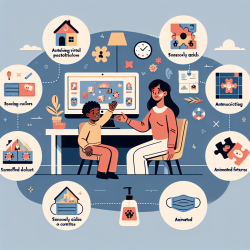Introduction
The COVID-19 pandemic has significantly altered the landscape of work, particularly for individuals with disabilities. As a company dedicated to providing online therapy services, TinyEYE is uniquely positioned to leverage these changes to create better outcomes for children. By examining the findings from the research article "An Accommodation for Whom? Has the COVID-19 Pandemic Changed the Landscape of Flexible and Remote Work for Workers with Disabilities?" we can gain insights into how remote work can be a tool for inclusivity and accessibility.
Understanding the Research
The research highlights that while flexible and remote work was initially seen as a solution to increase employment rates among people with disabilities, the reality is more complex. Data from the Current Population Survey and the American Community Survey indicate that workers with disabilities, particularly those who are multiply marginalized, have not benefited equally from the shift to remote work.
Key Findings
- Prior to the pandemic, workers with disabilities reported similar rates of flexible and remote work as their non-disabled counterparts.
- During the pandemic, workers with disabilities had lower rates of remote work compared to non-disabled workers.
- Demographic factors such as race, gender, and education significantly influence access to remote work, with white, female, and college-educated disabled workers more likely to access these options.
Implications for Practitioners
For practitioners at TinyEYE, these findings underscore the importance of considering intersectionality when designing therapy programs. By understanding the diverse experiences of children with disabilities, practitioners can tailor their approaches to meet the unique needs of each child. This may involve:
- Implementing flexible scheduling to accommodate different needs.
- Using technology to bridge gaps in accessibility.
- Engaging with families to understand the specific challenges they face.
Encouraging Further Research
The study also highlights the need for further research into how remote work can be optimized for people with disabilities. Practitioners are encouraged to explore questions such as:
- How can remote therapy be made more accessible for children with diverse needs?
- What role does technology play in enhancing therapy outcomes?
- How can we ensure that remote work benefits all children, regardless of their background?
Conclusion
As we continue to navigate the post-pandemic world, it's crucial to leverage the insights gained from research to enhance our practices. By focusing on inclusivity and accessibility, TinyEYE can ensure that all children have the opportunity to thrive. To read the original research paper, please follow this link: An Accommodation for Whom? Has the COVID-19 Pandemic Changed the Landscape of Flexible and Remote Work for Workers with Disabilities?










